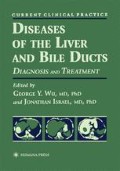Abstract
Drugs can cause a variety of reactions in the liver, presenting as hepatitis, cholestasis, granulomatous disease, and tumors. Drug-induced hepatotoxicity may cause acute liver failure and death. Hepatotoxic agents can be divided into two categories: intrinsic hepatotoxins that cause direct injury in a dose dependent manner and, more commonly, idiosyncratic reactions. Idiosyncratic reactions can further be divided into those causing an immunoallergic response and those produced probably through generation of a toxic metabolite. Idiosyncratic reactions are by definition unpredictable and may not occur for months after starting a drug. Genetic traits and external factors likely play a role in idiosyncratic reactions.
Access this chapter
Tax calculation will be finalised at checkout
Purchases are for personal use only
Preview
Unable to display preview. Download preview PDF.
References
Zimmerman, HJ. Hepatotoxicity: the adverse effects of drugs and other chemicals on the liver. Appleton-Century-Crofts, New York, 1978.
Scheuer PJ. Rifampicin hepatitis: a clinical and histological study. Lancet 1974; 1:421–425.
Mitchell JR. Isoniazid liver injury: clinical spectrum, pathology, and pathogenesis. Ann Int Med 1976;84:181–192.
Baily WC. The effect of isoniazid on transaminases levels. Ann Int Med 1974;81:200–202.
Mitchell JR. Acetylation rates and monthly liver function tests during one year of isoniazid preventive therapy. Chest 1975;68:181–190.
Kopanoff DE. Isoniazid-related hepatitis. A U.S. Public Health Service Cooperative Surveillance Study. Am Rev Respir Dis 1978;991–1001.
Snider DE. Isoniazid-associated hepatitis deaths: a review of available information. Am Rev Respir Dis 1992; 145:494–497.
Gurumurthy P. Lack of relationship between hepatic toxicity and acetylator phenotype in three thousand South Indian patients during treatment with isoniazid for tuberculosis. Am Rev Respir Dis 1984; 129:58–61.
Rigas B, Spiro HM. Clinical gastroenterology companion handbook, 4th ed. McGraw-Hill, New York, 1995, p. 574.
American Thoracic Society. Control of tuberculosis in the United States. Am Rev Respir Dis 1992; 146:1623–1633.
Rabinovits M. Hepatotoxicity of non-steroidal anti-inflammatory drugs. Am J Gastro 1992;87:1696–1704.
Zimmerman HJ, Maddrey WC. Toxic and drug-induced hepatitis. In: Schiff L, Schiff ER, eds. Diseases of the liver. JB Lippincott, Philadelphia, 1993, pp. 707–783.
Schiff E, Maddrey W. Can we prevent nonsteroidal anti-inflammatory drug-induced hepatic failure? Gastrointest Dis Today 1994;3:7–13.
Hamlyn AN. The spectrum of paracetamol acetaminophen overdose: clinical and epidemiologic studies. Postgrad Med 1978;54:400–404.
Heathcote J. Hepatotoxicity: newer aspects of pathogenesis and treatment. Gastroenterologist 1995;3:119–129.
Smilkstein MJ. Efficacy of oral N-acetylcysteine in the treatment of acetaminophen overdose. N Engl J Med 1988;319:1557–1562.
Cheung L. Acetaminophen treatment nomogram. N Engl J Med 1994;330:1907,1908.
Stricker NJ, Spoelstra P. Drug-induced hepatic injury: a comprehensive survey of the literature on adverse drug reactions up to January, 1985. Elsevier, Amsterdam, 1985, p. 240.
Strieker BH. Drug-induced hepatic injury, 2nd ed. Elsevier, Amsterdam, 1992, p. 241.
Farrell, GC. Drug Induced Liver Disease. Churchill Livingstone, New York, 1994, p. 502.
Roenigk HH, Auerbach R, Maibach HI. Methotrexate in psoriasis: revised guidelines. J Am Acad Dermatol 1988;19:145–156.
Kremer JM. Methotrexate for rheumatoid arthritis: suggested guidelines for monitoring liver toxicity. Arth Rheum 1994;37:316–328.
Kowalski TE, Falestiny M, Furth E, Malet PF. Vitamin A hepatotoxicity: a cautionary note regarding 25,000 IU supplements. Am J Med 1994;97:523–552.
Editor information
Editors and Affiliations
Rights and permissions
Copyright information
© 1998 Springer Science+Business Media New York
About this chapter
Cite this chapter
Li, T.C., Versland, M.R., Wu, G.Y. (1998). Drug-Induced Hepatotoxicity. In: Wu, G.Y., Israel, J. (eds) Diseases of the Liver and Bile Ducts. Current Clinical Practice. Humana Press, Totowa, NJ. https://doi.org/10.1007/978-1-4612-1808-1_13
Download citation
DOI: https://doi.org/10.1007/978-1-4612-1808-1_13
Publisher Name: Humana Press, Totowa, NJ
Print ISBN: 978-1-4612-7293-9
Online ISBN: 978-1-4612-1808-1
eBook Packages: Springer Book Archive

